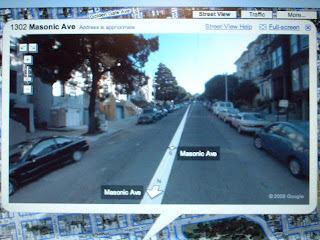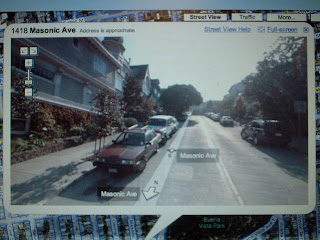
In addition to being a means by which I have acquired quite a few of my house postcards, the internet has also been a wonderful tool for researching my homes. Until recently, pretty much the only internet tools I had at my disposal were general Google-type searches and basic map sites. More recently a friend who subscribes to genealogical sites has been kind enough to help me by searching online U.S. census databases to which he as access. This has allowed me to find some homes that have only people's names attached to them. I've been using satellite map sites to see if I can zoom in clearly enough to examine the roofs of houses if I have the exact street address (and if those street addresses are still accurate) to see if the houses are still standing. But most recently, I've discovered "street views" on Google Maps. Here's a view of my old house in Tillamook, Oregon:

It allows you not only to see a view of the building at that street address, but allows you to travel up and down streets and spin around 360 degrees at any spot you want. So you can get several different views of the same house as you pass it by.
Armed with this new tool, I hunted my collection for homes identified with exact street addresses--usually just houses in larger cities as most small towns didn't have a need to have house numbers. I was able to find about 20 or 30 homes this way over the course of several nights. I also used "street view" to hunt for a home I've had in my collections for years, pictured under construction at the top of this page. Here is a view of the back of the postcard:

The message on the front reads, "Ue-oak-pi (sunny hillside) Maidu Indian" along with the initials MLP. It was mailed to Mrs. B.S. Rector, Nevada City, California and was postmarked from San Francisco on August 15, 1910. The message reads, "San Francisco Aug. 14-1910. My dear Mrs. Rector, Here is a view of our new house - this is the front, the front door is open and the latch string is out. Our Indian name for it is Ue-oak-pi or Ogeedonkee + you will I know call it worse than that, if you climb Masonic Ave. hill on a warm day. Best love to you all - Lovingly - Minerva-". Unfortunately, that gives me no last name to work with and no exact address. What it did give me is some tantalizing clues tailor made for this new street views. Even though I've been so anxious to go hunting in person for this home next time I'm down to the Bay Area visiting family, I decided to undertake the Google street view hunt. I had already looked on the satellite views about a year ago and could tell that there was a hill at the bottom of Masonic Avenue and that Masonic lead up to several other streets and I had no way of knowing whether or not this house is/was actually located on Masonic, but it was a good place to start. Here is a view looking up Masonic as it starts to climb upwards:

And it gets even steeper:

As I climbed the hill, I had to carefully look to the right and left, looking for houses with the basic roof outlines of the house pictured under construction and the unusual placement of windows. That ruled out most homes right away. I passed a few arts and crafts style homes that looked promising, but none matched up.

I found one that looked good, but couldn't get a real good view as it was really close to the street and partially obscured by trees. I tried viewing it from up above, down below and straight on, but still couldn't get a really good view. I spent another hour traveling up and around all the streets up and above this houses, but ultimately came back to it to take another look. Here's the house I found:

I couldn't find the exact street number of this house, but could tell it was somewhere in the 1500 block of Masonic. I tried a series of Google and Google Image searches and eventually found a better picture of the house listed as the E.B. Powers home at 1526 Masonic:

This photo allowed me to positively identify the house. Not only had I found the house, but I found a house designed by Bernard Maybeck, who was my dad's favorite architect! I have two of my dad's books on Maybeck's work and although the house shows up in the list of projects, there were no further photos of it. I also found this website which details the property, including information about the sender of the postcards, now identified as Minerva Powers, who grew up in Nevada City where the postcard was sent. It also shows some of the wonderful interior details for which Maybeck was known. As much fun as it was to find it online, I still think I would have rather experienced the climb up Masonic Avenue in person as described by Minerva 98 years ago. Of course I will do that myself next time I'm down that way so I can take a photo of it for my collection.




